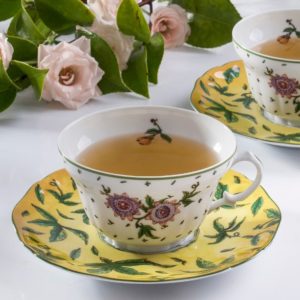No wonder the world’s healing traditions hold tea in such high esteem – tea offers so many wonderful benefits – and it’s just so civilized!
Green, black, white, or herbal – these wonderful aromatic beverages have been used for millennia to promote health, relaxation, and clarity of mind.

Botanists and healers distinguish between herbal teas and the three “true teas” – green, black, and white – that are derived from the plant camelia sinensis.
While the true teas share a number of benefits, it’s green tea’s healing qualities that have captured the attention of researchers, owing to its fat-burning, anti-inflammatory and anti-carcinogenic properties.
The antioxidants in green tea protect the heart and blood vessels, and the methylxanthines (similar to caffeine) are used in bronchodilators. Methylxanthines also increase the release of neurotransmitters and stimulate the nervous system.
Herbal teas (also known as “tisanes”) have numerous uses, depending on the plant species and whether the tea is brewed from roots, leaves, petals, or bark.
By the way, isn’t tisanes a great word? The Oxford Living Dictionary tells us it comes from late Middle English, where it meant “medicinal drink.” It descended from Greek ptisane (“peeled barley” – the Greeks enjoyed their barley tea), to Latin ptisana, and finally to French tisane. The word was introduced to English-speaking lands in the 20th century.
 Among the uses for herbal teas: dandelion root for liver, dandelion leaf for kidneys, chamomile flowers for relaxation, and cinnamon bark for blood sugar control.
Among the uses for herbal teas: dandelion root for liver, dandelion leaf for kidneys, chamomile flowers for relaxation, and cinnamon bark for blood sugar control.
The smoky-bitter teas of Chinese herbal medicine are brewed from all of the plant parts, with the intoxicating aromas a pleasing bonus.
Aside from their healing properties, what value do we derive from tea?
What greater pleasure than to enjoy this tasty, comforting, thoroughly civilized drink with its many pleasing social and cultural associations?
Friends can share in the ritualistic preparation of tea. Tea tantalizes the palate and the senses of smell and sight. Tea promotes contemplation, elicits memories, and soothes the soul.
Tea recalls grandma’s antique china cups, the silver tea samovars of the Trans Siberian Railway, and the buttery chai sold by teahouses in Nepal.
 Tea is a global pleasure – in Scotland it’s served with scones and tea sandwiches, and poured into teardrop glasses in Turkey. The scent of apple tea permeates the spice markets of Istanbul, and mint tea sweetens the atmosphere of Marrakech cafes.
Tea is a global pleasure – in Scotland it’s served with scones and tea sandwiches, and poured into teardrop glasses in Turkey. The scent of apple tea permeates the spice markets of Istanbul, and mint tea sweetens the atmosphere of Marrakech cafes.
The Japanese tea ceremony elevates teatime to an art form. The exquisite bowls are crafted by artisans whose names are legend. The tea ceremony celebrates the senses with sounds of macha powder being whisked to a foam, the turning of the bowl, and the ritual sipping.
Like all good things, drinking tea in excess can take a toll. Tea can tint our teeth, and the methylxanthines can cause heart palpitations and disrupt sleep. The flavonoids in tea can bind to the iron in plant foods, decreasing the iron available to the body. And some brews contain fluoride. So, as in all things, it’s good to observe a few commonsense precautions: be moderate, choose organic, and enjoy!
****
Learn about Dr. Connie’s work HERE.
